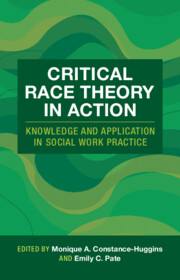Book contents
- Critical Race Theory in Action
- Critical Race Theory in Action
- Copyright page
- Contents
- About the Editors
- Contributors
- Acknowledgments
- Part I Introduction
- Part II Case Studies in Micro-Level Practice
- Part III Case Studies in Mezzo-Level Practice
- Case 3.1 White Privilege at the Work Opportunity Center
- Case 3.2 You Got What?
- Case 3.3 Making Visible the Invisible
- Case 3.4 What Am I Missing?
- Case 3.5 Don’t Forget to Shine!
- Part IV Case Studies in Macro-Level Practice
- Index
- References
Case 3.4 - What Am I Missing?
The Role of Intersectionality in Child Welfare Practice and Professional Relationships
from Part III - Case Studies in Mezzo-Level Practice
Published online by Cambridge University Press: 25 October 2025
- Critical Race Theory in Action
- Critical Race Theory in Action
- Copyright page
- Contents
- About the Editors
- Contributors
- Acknowledgments
- Part I Introduction
- Part II Case Studies in Micro-Level Practice
- Part III Case Studies in Mezzo-Level Practice
- Case 3.1 White Privilege at the Work Opportunity Center
- Case 3.2 You Got What?
- Case 3.3 Making Visible the Invisible
- Case 3.4 What Am I Missing?
- Case 3.5 Don’t Forget to Shine!
- Part IV Case Studies in Macro-Level Practice
- Index
- References
Summary
The case demonstrates how disproportionality and disparity for children and youth of color are significant concerns in child welfare. Black children in the United States experience higher rates of child welfare investigation, removal from their families of origin, termination of parental rights, placement moves, fewer appropriate services, and are less likely to be reunified with their parents compared to White children. Because African American children are less likely to exit foster care through reunification than White children, increasing reunification rates for African American families is one way to address racial disproportionality and disparity in child welfare cases. Considering intersectionality through a CRT lens is essential for providing culturally appropriate service in the foster care/child welfare system.
Keywords
Information
- Type
- Chapter
- Information
- Critical Race Theory in ActionKnowledge and Application in Social Work Practice, pp. 97 - 110Publisher: Cambridge University PressPrint publication year: 2025
